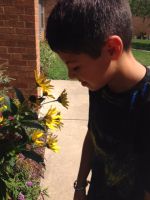Hamilton Early Childhood Elementary Center special education teachers Julie Gaines and Sue Farnham recognize when their preschoolers are overwhelmed, need a break or could simply benefit from time outdoors.
Now they have a place to bring their youngsters. Many have sensory processing issues and find relief in listening to the soft music of wind chimes, sinking their bare toes into sand, smelling lavender, touching shiny rocks and feeling the breeze or sunshine. They can blow bubbles or check out a colorful peace pole, and the state of tranquility and moments of freedom work wonders, the educators say.
Hamilton staff and custodians recently transformed a small school courtyard into a sensory garden, offering a calming place where students can roam, develop a host of skills and use their five senses in ways they are comfortable.

“It’s a great place for them to safely explore,” Gaines said. “They get to make the decision about what to do out there. There are a lot of things to touch… sand is very popular. When our students have been working hard on a focused activity and they’ve concentrated hard, they might need a break.”
But it goes beyond needing recess time. Children with sensory processing issues inappropriately interpret or organize information taken in by the five senses. For example, an everyday sound such as the hum of a fan that would hardly be noticed by most, might be highly irritating to someone with sensory processing issues; or the feel of clothing might be offensive. A person with sensory challenges might also crave sensory input and want to touch everything, or push heavy objects, or to hear a particular sound repeatedly.
“Our sensory garden offers our children a variety of sights, sounds, textures, smells and experiences that they can explore at their own pace and according to their comfort level,” Gaines said. “The natural light and open space is less irritating than an indoor room might be for them. And of course the beauty of nature, fresh air and sunshine is healthy for the staff too.”

An Outdoor Extension
Hamilton has had an indoor sensory room — with swings, a ball pit, bicycles and other items — since it opened four years ago. Along with break-time for overly stimulated students, it’s also used for gross and fine motor-skill development by occupational and physical therapists. The room abuts the sensory garden.
Hamilton houses Kentwood Public Schools’ preschool programs, a Bright Beginnings Program for infants to 3-year-olds and the district’s special-education early childhood program. All students will use the garden at some point, with special education classes using it the most, said Lori Eaton, the center’s director.
The garden provides hands-on learning. Students can touch plants, watch ants do their busy work in an ant farm, and walk a path made from rocks, mulch and logs.

“It’s going to be amazing,” Eaton said. “Through every sense of the word, they can learn so much out there.”
Farnham, also a speech pathologist, has already used the garden for summer school to meet sensory needs as well as help with motor skill development, language development and communication.
CONNECT
Sensory Processing Disorder









